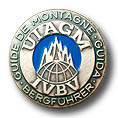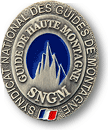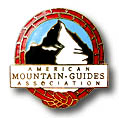
 |
|
| Kyajo Ri Expedition, 6186 meters |  |
|
Difficulty Dates Maximum
Ratio
|
In the Khumbu Himal, running just north of Namche Bazaar, is a long line of peaks continuing all the way to Cho Oyu on the Nepalese-Tibetan border. With the Thame valley to the west and the Gokyo valley to the east the 6186 meter (20,290 feet) high Kyajo Ri is the highest summit on the southern part of this ridge. Over the years, on continents far and wide, we have searched for "perfect" peaks to guide. Our criteria have been pretty limiting, and climb after climb, summit after summit, though we have enjoyed them all, usually there is some serious downside to any particular route. In the Khumbu, which we have visited often, we think that Kyajo Ri comes closest to our ideal. Here's why we like it:
History The peak was opened to climbing by the Nepalese Ministry of Tourism, in 2002 and the first (official) ascent was made that year by a Franco/British team. They approached from Machhermo, traversed the Kyajo Glacier and climbed via the Southwest Ridge. The same route was repeated in 2003 by a French team as an acclimatization outing in preparation for the difficult North Face of Machhermo peak, which they then climbed (Bonfire of the Vanities). Also in 2003, a Dutch team climbed the Southwest Ridge route after failing on an attempt of the east face. In 2005 An American team climbed the more difficult Southeast Ridge establishing only the second route on the peak. There have been a few other attempts on the mountain – an Australian in 2005 and an American in the spring of 2006, a Korean (perhaps), and possibly others. There may have been other attempts or even ascents of the peak prior to its official opening in 2002. At the location of our high camp (which is not the location of any camps from the above expeditions) we found a few old cans and rock tent site enclosures. So someone had been there before us. In the Fall of 2004, Andy Latham and Kathy traveled to Nepal with their sites on Kyajo Ri. The lack of available information meant that they had to spend considerable time and energy simply scouting a reasonable approach to the peak. In the end they ran out of time for the climb, but did find what seemed to be the best approach to the mountain. The next year, in 2006, using this valuable information (thank you Andy and Kathy) Kathy and Mark returned, this time with Emery Dameron, Jean-Claude Latombe and Matt Scott. We had a great expedition, exploring a different approach from the south and climbing via the SW Ridge with everyone summitting. We liked the trip so much that we have decided to offer it again in the Fall of 2007. On our 2007 expedition we were joined by Pamela Bjorkman, Minx Fuller and Connie Garret. We reached a high point of about 6030 meters (19,780') on the Southwest Ridge, but were not able to summit due to time constraints and the intense cold. Our Trip Our proposed itinerary, which follows that we took in 2007, starts with a trek and circumnavigation of the peak. The trek is a pleasure in itself and also insures that we are adequately acclimated for the climb. Our trekking route follows the main "Everest Base Camp Route" as far as Namche Bazar. Then we leave the main route, and head to Gokyo, another popular destination. From here we cross the Renjo La, a high pass between the Gokyo Valley to the east and the Thame valley to the west. We trek down the valley to Thame and then to Mende, where we leave the main trails and enter the Kyajo Drangka, the hidden valley to the south of Kyajo Ri. From Base Camp we establish Camp I at about 5350m. We then move up to Camp 2 at about 5700m, and summit the following day. The entire trip is 27 days long, including a couple days in Kathmandu at the start, the trek and climb. For more detailed information on the itinerary read on down below. Even though Base Camp is in a very remote, seldom visited valley, it is not overly difficult to reach. Trekking spouses or friends are welcome to join us. An Admission (and suggestion) We seriously thought about not including a description of our previous trips in our Recent Trips Gallery and removing any really useful planning information from this page. Once word got out, we feared the seemingly inevitable littering and piles of half-burned trash that befalls all the popular base camps. We would lose our "exclusive" knowledge about the special nature of the Kyajo Drangka (the valley in which we placed our base camp) and about the good quality of the climb. We enjoyed the fact that there was NOBODY else there, tucked away as we were in our own private valley. In the end, however, we concluded that news would unavoidably spread, and that the best thing we can do is to encourage behavior that can at least delay or limit the damage to this unique place. With those ideas in mind we offer a few thoughts for others who might be considering putting together an expedition or trekking trip into the Kyajo Drangka. Thoughts on protecting the Kyajo Drangka. |
|||||
 |
|
| Kyajo Ri from Camp 1. | |
Difficulty This is a difficult expedition. There is significant technical climbing at high altitude. Summit day is very long and tiring. The approach trek to base Camp is not overly difficult and is suitable for experienced off-trail hikers in good condition. In difficulty it is probably comparable to the Cho La route, or to treks that cross the Renjo La, and perhaps a bit harder than the Kala Patar trek near Everest Base Camp. Base Camp to Camp 1 is a long way, and a hard day over rough, but non-technical terrain. Camp 2 is not so far from Camp 1 but the interveneing climbing is occsionally over difficult tallus and giant boulders From Camp 2 we are able to move together a short way, then soon begin belayed climbing. We climb about 12 pitches of steep snow and ice, to perhaps 65° in steepness for one or two pitches just below the summit. We will belay, lower and rappel the same route on descent. Overall, the difficulty is comparable to the summit day on Ama Dablam. Kyajo Ri is significantly harder physicallly and technically than Lobuche East-East or Island Peak. We can expect
porter in helping to bring group gear up to and down from Camp 2. Climbers need to be in excellent physical condition, and have lots of experience climbing in crampons, both on moderately steep ice with two tools, as well as on easy mixed terrain. They should be comfortable following waterfall ice routes of Grade 4. Previous high altitude experience is required. |
||||
 |
|
| Moving up to Camp 2. | |
| Kyajo Ri Expedition Itinerary |
|||||||||
Day
-2 |
Depart North America. | ||||||||
| Day
-1 |
In transit for North Americans flying west. Depart Europe for those flying east. | ||||||||
| Day 0 |
Arrive in Kathmandu. Flights from Bangkok (Thai Airways and partners) usually arrive around noon. |
||||||||
| Day 1 |
Relax, sightsee and organize in Kathmandu. |
||||||||
| Day 2 |
Fly to Lukla at 2840m (9300 feet), and continue our trek to Phakding, 2610 meters (8560 feet). |
||||||||
| Day
3 |
Continue our trek to Namche Bazar 3440 meters (11,280 feet). |
||||||||
| Day
4 |
Rest, acclimate in Namche Bazar. A walk up to Khumjung is a good outing and takes us up to 3840 meters (12,600 feet). Here we get our first open views of Everest and Ama Dablam. |
||||||||
| Days
5 |
From Namche Bazar we start out on the normal "Everest Base Camp" trek but soon leave it, heading instead towards Gokyo. We will likely camp in Phortse Tenga at about 3600m (11,800'). |
||||||||
| Day
6 |
Trek to Machhermo at 4410 meters (14,460 feet). Machhermo lies at the foot of the east face of Kyajo Ri. |
||||||||
| Day
7 |
Continue our trek up to Gokyo at 4790 meters (15,700 feet). Gokyo is known for its beautiful lake and also for a nearby summit called Gokyo Ri. |
||||||||
| Day
8 |
Trek up Gokyo Ri 5360 meters (17580 feet) and return to Gokyo. |
||||||||
| Day
9 |
From Gokyo, we head west crossing the high pass of the Renjo La at 5411m (17,750'). We continue down the west side of the pass, descending all the way down to Lungden at 4500m (14,760').
|
||||||||
| Day
10 |
We continue to trek down-valley to Thame at 3800m (12,500'). |
||||||||
| Day 11 |
From Thame we turn east, heading back in the direction of Namche Bazar and almost completing an entire circumnavigation of Kyajo Ri. We will camp in Mende, 3740m (12,270') a small town at the entrance of the Kyajo Drangka. |
||||||||
| Day 12 |
Above Mende we leave the main trails and follow a faint yak trail up over a couple passes to enter the Kyajo Drangka; the isolated broad valley south of our peak. It is a longish day to Base Camp, which we place at about 4550m (14,900'). |
||||||||
| Day 13 |
Rest and reorganize in Base Camp. |
||||||||
Day
14 |
Carry to Camp I at the base of the Kyajo Glacier at about 5350 (17,550'). This is a great location for high camp, on level ground, with good views and within easy reach of water flowing out from the frozen lake at the foot of the Glacier. Return to Base Camp. | ||||||||
Day
15 |
Rest in Base Camp. (In 2006 and 2007 we took two rest days before moving back up to Camp 1.) |
||||||||
Day
16 |
Second rest day in Base Camp as needed. | ||||||||
Day
17 |
Move up to Camp 1. |
||||||||
Day
18 |
Rest in Camp 1. There is a bit of rope fixing that needs to hapen between Camps 1 and 2 and this is a good day for that. | ||||||||
Day
19 |
Move up to Camp 2 at about 5700 meters (18,700 feet). |
||||||||
Day
20 |
From Camp 2 climb up to the broad saddle at the base of the Southwest Ridge. Here the ground steepens, and we climb snow and ice on the Southwest Ridge. There is one short rock section but primarily the climbing is on snow and ice. The sharp summit is a narrow wedge of snow. Return to Camp 2.
|
||||||||
Day
21 |
Descend to Base Camp. |
||||||||
Day
22 - 23 |
Two extra days. We want to keep these days in reserve, both to allow for health, as well as weather. If we don't need them for Kyajo Ri, there are many options on how to spend them, ranging from returning home early, to exploring other parts of the Khumbu or Nepal. In 2006 we actually flew out from Lukla early and spend a couple days at the Island Jungle Resort in Chitwan National Park, riding elephants searching out rhinos and crocodiles! |
||||||||
Day
24 |
Trek from Base Camp to Namche Bazar. | ||||||||
Day
25 |
Trek from Namche Bazar to Lukla. |
||||||||
Day
26 |
Fly Lukla to Kathmandu. | ||||||||
Day
27 |
In Kathmandu. | ||||||||
Day
28 |
Depart for home country. | ||||||||
Day
29 |
Arrive home country. | ||||||||
|
||||
|
Kathy
Cosley & Mark Houston AMGA Certified • SNGM members    |
||||